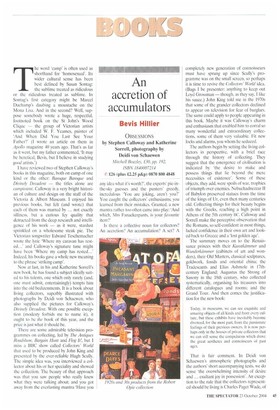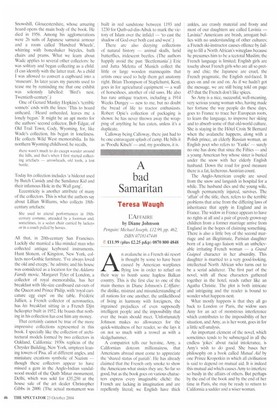An accretion of accumulators
Bevis Hillier
OBSESSIONS by Stephen Calloway and Katherine Sorrell, photography by Deidi von Schaewen Mitchell Beazley, £30, pp. 192, ISBN 1840007214 (4) £26 (plus £2.25 p&p) 0870 800 4848 r-/-1 he word 'camp' is often used as shorthand for 'homosexual'. Its wider cultural sense has been best defined by Susan Sontag: the sublime treated as ridiculous or the ridiculous treated as sublime. In Sontag's first category might he Marcel Duchamp's daubing a moustache on the Mona Lisa. And in the second? Well, suppose somebody wrote a huge, respectful, footnoted book on the St John's Wood
Clique the group of Victorian artists which included W. F. Yeames, painter of 'And When Did You Last See Your Father?' (I wrote an article on them in Apollo magazine 40 years ago. That's as far as it went, but my father commented, 'It may be heretical, Bevis, but I believe in studying good artists.') I have reviewed two of Stephen Calloway's books in this magazine, both on camp of one kind or the other: Baroque Baroque and Divinely Decadent — the titles alone are campissimi. Calloway is a very bright historian of culture and design on the staff of the Victoria & Albert Museum. I enjoyed his previous books, but felt (and wrote) that each of them was marred by ... not exactly silliness, but a curious fey quality that detracted from the deep research and intelligence of his work — as it were, stardust sprinkled on a wholesome steak pie. The Victorian songwriter Edward Teschernacher wrote the lyric 'Where my caravan has rested...' and Calloway's signature tune might have been 'Where my camp has rested...' Indeed, his books gave a whole new meaning to the phrase 'striking camp'.
Now at last, in his and Katherine Sorrell's new book, he has found a subject ideally suited to his talents, one which only rarely (and, one must admit, entertainingly) tempts him into the old bedizenments. It is a book about living collectors, superbly illustrated with photographs by Deich von Schacwen, who also supplied the pictures for Calloway's Ditlneiy Decadent. With one possible exception (modesry forbids me to name it), it ought to be the book of this year, and the price is just what it should he There are some admirable television programmes on collecting, led by The Antiques Roadshovv, Bargain Hunt and Flog It!, but I miss a BBC show called Collectors' World that used to be produced by John King and presented by the ever-reliable Hugh Scully. The simple idea was, you interviewed a collector about his or her speciality and showed the collection. The beauty of that approach was that you saw people who really knew what they were talking about; and you got away from the everlasting mantra 'Have you any idea what it's worth?', the experts' pie-inthe-sky guesses and the punters' greedy, incredulous 'You are joking, aren't you?' You caught the collectors' enthusiasms; you learned from their mistakes. Granted, a new mantra rather too often came into play: 'And which, Mrs Fanackerpants, is your favourite item?'
Is there a collective noun for collectors? An accretion? An accumulation? A set? A completely new generation of connoisseurs must have sprung up since Scully's programme was on the small screen, so perhaps it is time to revive the Collectors' World idea. (Bags I be presenter: anything to keep out Loyd Grossman — though, as they say, I like his sauce.) John King told me in the 1970s that some of the grander collectors declined to appear on television for fear of burglars. The same could apply to people appearing in this book. Maybe it was Calloway's charm and enthusiasm that enabled him to corral so many wonderful and extraordinary collections, some of them very valuable. Fit new locks and alarms, you whom he seduced.
The authors begin by setting the living collectors in perspective, with a brief race through the history of collecting. They suggest that the emergence of civilisation is indicated by 'the desire to make and possess things that lie beyond the mere necessities of existence'. Some of these objects, they add, were spoils of war, trophies of triumph over enemies. Nebuchadnezzar II of Babylon preserved statues from the time of the kings of Ur, even then many centuries old. Collecting things for their beauty begins with the Greeks, reaching a high point in Athens of the 5th century BC. Calloway and Sorrell make the perceptive observation that the Romans, so self-confident in most things, lacked confidence in their own art and looked back to Greece and a 'lost golden age'.
The summary moves on to the Renaissance princes with their Kunstkarnmer and Wunderkeimmer (cabinets of art and wonders), their Old Masters, classical sculptures, goldwork, fossils and oriental china; the Tradescants and Elias Ashmole in 17thcentury England; Augustus the Strong of Saxony in the 18th century, who collected systematically, organising his treasures into different catalogues and rooms; and the Grand Tour, And then comes the justification for the new book:
Today, in museums, we can see exquisite and amazing objects of all kinds and from every culture, but these exhibits have inevitably become divorced, for the most part, from the passionate feelings of their previous owners. It is now perhaps only in the houses of private collectors that we can still sense the compulsions which drove the great aesthetes and connoisseurs of past ages.
That is fair comment. In Deidi von Schaewen's atmospheric photographs and the authors' short accompanying texts, we do sense 'the overwhelming intensity of desire and ... exultant joy in possession'. An exception to the rule that the collectors represented should be living is Charles Paget Wade, of
Snowshill, Gloucestershire, whose amazing hoard opens the main body of the book. He died in 1956. Among his agglomerations were 26 suits of Japanese samurai armour and a room called 'Hundred Wheels', whirring with boneshaker bicycles, bath chairs and prams. What we learn about Wade applies to several other collectors: he was solitary and began collecting as a child. (I can identify with the latter trait. As a child I was allowed to convert a cupboard into a 'museum', In later years my parents used to tease me by reminding me that one exhibit was solemnly labelled: 'Bird's nest. Twentieth-century'.) One of Gerard Manley Hopkins's 'terrible sonnets' ends with the lines: 'This to hoard unheard, / Heard unheeded, leaves me a lonely began.' It might be an apt motto for the authors' second collector, Bob Edgar, of Old Trail Town, Cody, Wyoming, for, like Wade's collection, his began in loneliness. He collects Wild West memorabilia. In his northern Wyoming childhood, he recalls,
there wasn't much to do except wander around the hills, and that's when I first started collecting artefacts — arrowheads, old tools, a lost bottle.
Today his collection includes 'a hideout used by Butch Cassidy and the Sundance Kid and their infamous Hole in the Wall gang'.
Eccentricity is another attribute of many of the collectors. This is what the authors say about Lillian Williams, who collects 18thcentury artefacts:
She used to attend performances in 18thcentury costume, attended by a footman and, sometimes, in a sedan chair carried by lackeys or in a coach pulled by horses.
All that, in 20th-century San Francisco. Luckily she married a like-minded man who collected antique keyboard instruments. Hunt Slonem, of Kingston, New York, collects neo-Gothic furniture. 'I've always loved the old and creepy,' he admits; and his house was considered as a location for the Addams Family movie. Margaret Tyler of London, a collector of royal memorabilia, has her breakfast with life-size cardboard cut-outs of the Queen and Prince Philip, with 'royal caricature egg cups' on the table. Frederic Jullien, a French collector of aeronautica, has his breakfast sitting in a French Djin helicopter built in 1952. He boasts that nothing in his collection has cost him any money.
That certainly cannot be true of the more impressive collections represented in this book. I specially like the collection of architectural models formed by two collectors in Oakland, California: 1930s replicas of the Chrysler Building, New York, umpteen leaning towers of Pisa, all at different angles, and miniature creations symbolic of Nazism — though these collectors appear to have missed a gem in the Anglo-Indian sandalwood model of the Qutb Minar monument, Delhi, which was sold for £35,250 at the house sale of the art dealer Christopher Gibbs in 2000. (The actual monument was built in red sandstone between 1193 and 1230 for Qutb-ud-din-Aibak to mark the victory of Islam over the infidel — 'to cast the shadow of God over both east and west'.) There arc also dizzying collections of natural history — animal skulls, lurid butterflies, iridescent beetles. (The authors happily avoid the pun `Beetlemania'.) Eric and Jutta Meletta of Munich collect the little or large wooden mannequins that artists once used to help them get anatomy right. Brian Thompson of Staplehurst, Kent, goes in for agricultural equipment — a wall of horseshoes, another of old saws. He also has rare antique tractors, including a 1914 Weeks Dungey — new to me, but no doubt the bread of life to tractor enthusiasts. Robert Opie's collection of packaging is shown: he has never thrown away the wrapping of anything he has eaten, unless it's a duplicate.
Calloway being Calloway, there just had to be one extravagant splash of camp. He bills it as 'Poodle Kitsch' — and, my goodness, it is.

























































































 Previous page
Previous page